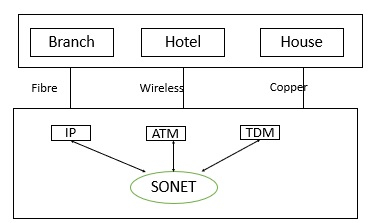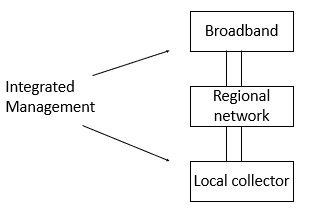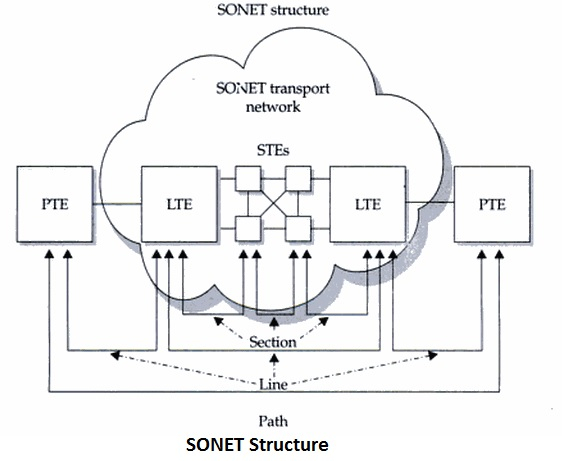
 Data Structure
Data Structure Networking
Networking RDBMS
RDBMS Operating System
Operating System Java
Java MS Excel
MS Excel iOS
iOS HTML
HTML CSS
CSS Android
Android Python
Python C Programming
C Programming C++
C++ C#
C# MongoDB
MongoDB MySQL
MySQL Javascript
Javascript PHP
PHP
- Selected Reading
- UPSC IAS Exams Notes
- Developer's Best Practices
- Questions and Answers
- Effective Resume Writing
- HR Interview Questions
- Computer Glossary
- Who is Who
What are the SONET/SDH standards in networking?
Let us understand what a SONET/SDH Transmission in computer networking is.
SONET/SDH Transmission
SONET stands for synchronous optical network. It offers cost effective transport both in the access area and core of the network.
The transport services for the metro are provided by the optical layer. The optical layer has been now giving services for synchronous transmission and performance monitoring.
Example − Telecom Network overview
The SONET/SDH transmission is diagrammatically represented as follows −

Its main role is that if some of the points in a network have not been working properly, the damaged sonnet has the capability to provide alternative points for the transport.

Multiplexing enables the physical medium to carry multiple signals. To place more than one cell on each link, it is some time slot. In SONET, multiplexing is not statistical.
It provides the ability to access traffic at a node without the need for complex packing and unpacking signals.
SONET Hierarchy
The SONET hierarchy is explained below in a stepwise manner −
Step 1 − SONET packages a signal into containers.
Step 2 − It then adds overhead, so that signal and the quality of transmission are traceable.
Step 3 − The containers have two names depending on size −
- Virtual Tributary (VT)
- Synchronous Payload Envelope (SPE).
Step 4 − SONET traffic is packaged in VT and transported in Synchronous signals.
Step 5 − The SONET line transmission rates are 50, 155, 622 Mbps and 2.5, 10 Gbps.
Step 6 − SONET is an American National Standards Institution for NA, while synchronous Digital hierarchy (SDH) is for the rest of the world.
Network Architecture of SONET
SONET is not just a simple replacement for SDA but a network in its own configuration, embedded switches and management.
The network architecture of SONET is diagrammatically given below −

Collector rings provide the network interfaces for all access applications. Sometimes, SONET is a multiplexer in customer premises. It checks that the switch processing element is filled to maximum.
Features
The features of SONET are given below −
- Network management
- Protection
- Bandwidth management
- Network simplification
- Mid fibre meet
Benefits
The benefits of SONET are given below −
- Increases revenues
- Improved services.
- Reduced operating cost.
- Centralized management.
- Reduced capital investment.
Main Goals
The main goals of SONET are given below −
- Fault tolerance.
- Interoperability among different manufactures.
- Flexibility of upper layer formats.
- Complex monitoring capabilities.
The diagram given below represents the SONET structure −


